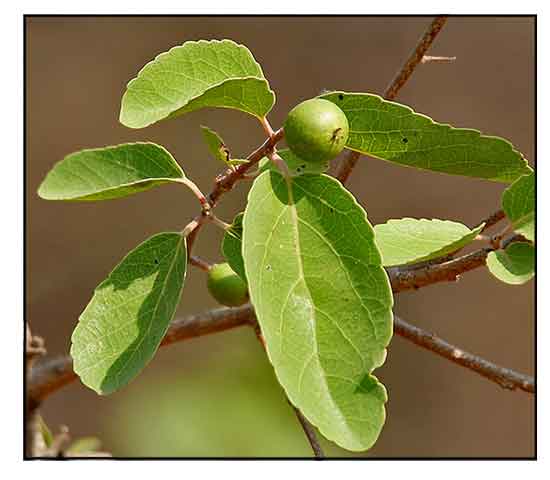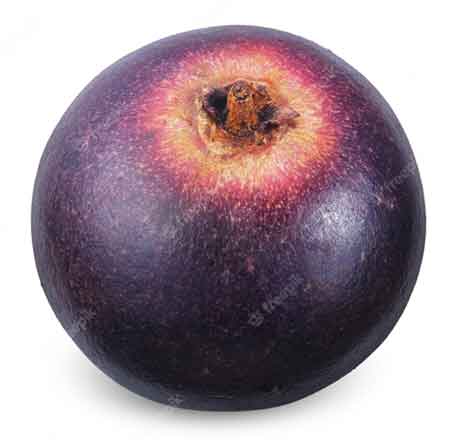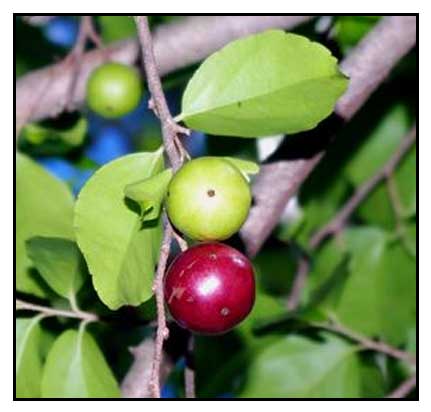|  Gen info Gen info
- Flacourtia is a genus of flowering plants in the family Salicaceae, previously placed in the now defunct family Flacourtiaceae. It contains 15 species of shrubs and small tress native to African and Asian tropics and subtropics. (34)
- Etymology:
The genus name Flacourtia honors Etienne de Flacourt (1607-1660), a governor of Madagascar. The specific epithet indica refers to the east as home of the little tree of Transvaal bushveld. (34) (28)
Botany
Palutan is an erect, branched, more or less spiny shrub of small tree, growing to a height of 3 meters. Spines are slender and scattered, up to 2 centimeters long. Leaves are obovate to oblong-ovate, 2.5 to 5 centimeters long, with toothed margins and rounded lobes, the based pointed with the tip rounded. Flowers are white, about 5 millimeters in diameter, borne on axillary or terminating short branchlets, solitary or in pairs. Fruit is rounded, about 1 centimeter in diameter, fleshy when fresh, smooth and purple or nearly black. Pulp is edible, fleshy and sweet, agreeable in flavor, enclosing 6 to 10 small,
flattened seeds.
 Distribution Distribution
- Native to the Philippines.
-
In dry thickets at low altitudes in Cagayan, Isabela, Zambales, Tarlac, Bataan, Rizal and Batangas Provinces in Luzon; and in Mindoro.
- Also native to Aldabra, Assam, Bangladesh, Botswana, Burundi, Cambodia, Cape Provinces, China Southeast, Comoros, Congo, Ethiopia, Hainan, India, Jawa, Kenya, KwaZulu-Natal, Laccadive Is., Laos, Lesser Sunda Is., Madagascar, Malawi, Malaya, Mozambique, Myanmar, Namibia, Nepal, Northern Provinces, Pakistan, Rwanda, Somalia, Sri Lanka, Sudan, Sulawesi, Tanzania, Thailand, Uganda, Vietnam, Zambia, Zaïre, Zimbabwe. (18)
Constituents
- Phytochemical screening of ethanoic extract of leaves yielded alkaloids, saponins, tannins, flavonoids, glycosides, phenolic compounds, terpenoids and steroids. (See study below) (7)
- Study of methanol extract of roots yielded flavonoids, saponins, alkaloids, tannins, terpenoids, glycosides, and phenolic compounds. (see study below) (22)
 - Study yielded a new phenolic glucoside, (rel)-2-(4',6' -dibenzoyl-beta-glucopyranosyloxy)-7-(1alpha-hydroxy-2alpha-ethoxy-6alpha-acetyloxy-3-oxocyclohex-4-enoyl)-benzyl alcohol (Flacourticin) (1) and the known, 2-(4',6'-dibenzoyl-beta-glucopyranosyl)-5-hydroxy benzyl alcohol (4'-benzoylpoliothrysoside) (2) together with the new, (2E)-heptyl-3-(3,4-dihydroxyphenyl) acrylate (3), (+)-catechin (4) and sitosterol-beta-D-glucoside were isolated from Flacourtia indica. (see study below) (24) - Study yielded a new phenolic glucoside, (rel)-2-(4',6' -dibenzoyl-beta-glucopyranosyloxy)-7-(1alpha-hydroxy-2alpha-ethoxy-6alpha-acetyloxy-3-oxocyclohex-4-enoyl)-benzyl alcohol (Flacourticin) (1) and the known, 2-(4',6'-dibenzoyl-beta-glucopyranosyl)-5-hydroxy benzyl alcohol (4'-benzoylpoliothrysoside) (2) together with the new, (2E)-heptyl-3-(3,4-dihydroxyphenyl) acrylate (3), (+)-catechin (4) and sitosterol-beta-D-glucoside were isolated from Flacourtia indica. (see study below) (24)
- Fruits are rich in copper and manganese.
Mineral analysis showed: (macroelement mg/100g) N 0.64 ± 0.025, P 0.13 ±0.017, K 1184.3 ±4.5, Ca 434.8 ±0.1, Mg 130 ±1/3, Na 146.3 ±1.5; (microelement mg/100g) Fe 1523 ±0.19, Zn 2.13 ±0.32, Cu 7.6 ±0.06, Mn 10.37 ±0.49. (26)
- Study isolated six compounds viz., (1) 2-(2-benzoyl-b-D- glucopyranosyloxy)-7-(1a,2a,6a-trihydroxy-3-oxocyclohex-4- enoyl)-5-hydrox -ybenzylalcohol, (2) poliothrysoside, (3) catechin-[5,6-e]-4b-(3,4- dihydro xyphenyl) dihydro-2(3H)- pyranone, (4) 2-(6-benzoyl-b-D-glucopyranosyloxy)-7- (1a,2a,6a-trihydroxy-3-oxocyclo hex-4-enoyl)-5- hydroxybenzyl alcohol (5), chrysoeriol-7-O-b-D- glucopyranoside and (6) mururin A. (see study below) (29)
Properties
- Bark is astringent.
- Dried leaves considered carminative, expectorant, tonic and astringent.
- Studies of various plant parts have demonstrated anti-inflammatory, antimicrobial, antioxidant, hepatoprotective, antimalarial, anxiolytic, anti-diabetic, anti-asthmatic, antibacterial, anticonvulsant, antidyslipidemic, anticancer, antiproliferative, antiviral, antiadipogenic. diuretic, antibiofilm, cardioprotective properties. (8)
Parts utilized
Bark, root, leaves, fruits.
 Uses Uses
Edibility
- Fruits are edible, eaten raw or stewed. Also dried or made into jams and jellies.
- Fruit used for making wine.
Folkloric
- In India, infusion of the bark used for hoarseness and as a gargle.
- In Madagascar, the bark is titurated in oil and used as a rheumatic liniment.
- The ashes of the roots are used for kidney ailments.
- Dried leaves are used in asthma, bronchitis, phthisis and catarrh of the bladder.
- Juice of fresh leaves and tender stalks used for fevers.
- As an antiperiodic for infants, 5 to 10 drops are placed in water or in mother's milk.
- Also used in phthisical coughs, dysentery, diarrhea and indigestion during dentition.
- In Bengal, used as a tonic during parturition.
- The fruit is used for bilious disorders and to relieve nausea and vomiting.
- In India, used as an antiviral.
- In Sabah, roots used for headaches, leaves for colic.
- In Tanzania, fruit used for jaundice and enlarged spleens; leaves and roots for schistosomiasis, malaria and diarrhea. Also, the roots are used for hoarseness, pneumonia, intestinal worms; and as astringent, diuretic and analgesic.
- In Africa, stem barks, fruits, and leaves used for epilepsy, headache, fever, stomach-ache, diarrhea, and sleep disorders. (27)
- In Sri Lanka, young fruit taken for internal hemorrhages; ripe fruit as liver tonic. Root power with kithul juggary taken as expectorant. Decoction of roots taken for treatment of urinary calculi. Gum used in treatment of cholera. (32)
Others
• Fodder: Grazed on by game. In India, branches and leaves lopped for cattle. (28)
• Tannin or dyestuff: Bark is used as tannin material. (28)
• Fuel: Wood used as firewood and charcoal. (28)
• Boundary / barrier: Closely planted, it forms an impenetrable hedge barrier. (28)
Studies
• Hepatoprotective / Paracetamol-Induced Hepatotoxicity / Aerial Parts:
Study of extracts of aerial parts of F indica in paracetamol-induced hepatic necrosis in rat models exhibited hepatoprotective effects probably mediated through the inhibition of the microsomal metabolizing enzymes. (1)
• Hepatoprotective / CCL4-Induced Hepatotoxicity: Study results conclude that aqueous extract of leaves of F indica protects the liver against oxidative damages and can be used as an effective protector against CCl4-induced hepatic damage. (4)
• Antimalarial: Study reports on the antiplasmodial activity of the AcOEt extract and three major constituents of Flacourtia indica. (5)
• Anti-Asthmatic / Leaves: Study evaluated the anti-asthmatic activity of ethanolic extract of leaves. Results showed anti-asthmatic activity with significant antihistaminic (H1-receptor antagonist) activity, bronchodilator and mast cell stabilizing property. (8)
• Diuretic / Roots: Study evaluated the diuretic activity of ethanolic extract of roots. Phyto screening yielded carbohydrates, tannins, phenolic compounds, and terpenoids. Results showed significant increase in urine volume as well as Na+, K+, Cl- ion concentration in albino rats. (9)
• Antimalarial / Aerial Parts: Study evaluated aerial parts for antimalarial activity. Decoction of plant material yielded three compounds: pyrocatechol, homaloside D, and poliothrysoside. The poliothrysoside exhibited strong antiplasmodial activity a good selectivity index similar to chloroquine. (10)
• Antioxidant / Leaves: Study evaluated methanolic and aqueous extracts of leaves of F. indica for antioxidant activity. Results showed potent antioxidant activity in all models when compared to ascorbic acid. Antioxidant activity was attributed to flavonoids and phenolics present in the extracts. (11)
• Anti-Anxiety: Study of an alcoholic extract of leaves showed significant anti-anxiety activity using a Elevated plus maze and Hole board method. Acute oral toxicity testing revealed an LD50 greater than 2000 mg/kbw. (12)
• Cardioprotective / Doxorubicin Cardiotoxicity: Study evaluated an ethanolic extract of F. indica against doxorubicin (DOX)-induced myocardial infarction in rats. Results showed pretreatment with the extract can prevent heart damage by DOX-induced injury in rats, likely mediated through its antioxidant activities. (13)
• Analgesic / Anti-Inflammatory: Study evaluated an alcoholic extract of aerial parts of Flacourtia ramontchii for analgesic activity in Swiss albino mice and Sprague Dawley rats. Results showed significant dose-dependent analgesic and anti-inflammatory activity in both acute as well as subacute animal models. (15)
• Anti-Inflammatory / Antimicrobial / Leaves: Study of chloroform and methanol extract showed promising anti-inflammatory activity in carrageenan induced rat paw edema model, equipotent to anti-inflammatory activity of standard indomethacin. The methanol extract showed broad spectrum antimicrobial activity at concentration of 1000 mg/ml. (16)
• Flacourtosides A-F/ Phenolic Glycosides / Chikungunya / Dengue: In search of novel inhibitors of chikungunya (CHIKV) and dengue (DENV) virus replication, ethyl acetate extracts of stem barks were studied in CHIKV virus-cell based assay and DENV NS5 RNA-dependent RNA polymerase (RdRp) assay. Study yielded six new phenolic glycosides, flacourtosides A-F, phenolic glycosides itoside H, xylosmin, scolochinenoside D and poliothrysoside and betulinic acid 38-caffeate. Significant inhibition was observed in the DENV RNA polymerase assay with betulinic acid 3ß-caffeate. Several fractions and extracts showed significant antiviral activity in the CHIKV virus-cell-based assay, while none of the purified compounds did. (17)
• Antidyslipidemic / Antioxidant / Anti-Adipogenic / Leaves: Study investigated the possible mechanism for the antidyslipidemic activity of hydromethanolic extract from F. indica leaves. F. indica at 150 mg/kg significantly lowers the plasma level of total cholesterol (17%), triglycerides (13%), and phospholipids (16%) by increasing post-heparin lipolytic activity (19%) and lecithin-cholesterol-acyltransferase activity (20%) in Triton-induced hyperlipidemic rats. The extract also showed significant in vitro antioxidant and anti-adipgenic activity. The extract was non-toxic up to a dose of 2000 mg/kbw in acute oral toxicity study. Results suggest potential in preventing clinical deterioration induced by dyslipidemia along with oxidative stress. (19)
• Antiproliferative / Pro-Apoptotic / Human Colon Cancer Cells / Aerial Parts: Study investigated the anticancer effects of methanolic extract of F. indica aerial parts in human colon cancer (HCT116) cells. Results showed Flacourtia indica possess anti-proliferative and pro-apoptotic effects in HCT116 cells and the effects are partly due to ROS dependent activation of caspases. (20)
• Hepatoprotective / Methotrexate-Induced Hepatotoxicity / Aerial Parts: Study evaluated petroleum ether extract of aerial parts for hepatoprotective effect in methotrexate induced hepatotoxicity in rat models. Results showed significant improvement in level of marker enzymes for liver function and oxidative stress, together with histopathological reversal of MTX induced necrosis. (21)
• Antibacterial / Roots: Study evaluated the antibacterial potential of F. indica root extract against selected human pathogenic bacteria. Results showed effective antibacterial activity with MIC values ranging from 50-200 mg/ml. (see constituents above) (22)
• Antidiabetic / Leaves: Study evaluated the antidiabetic effects of ethanolic extract of leaves of F. indica in STZ-induced diabetic rats. Results showed significant alterations in fasting blood glucose, serum triglycerides, serum cholesterol, liver glycogen, glycosylated hemoglobin and body weight in STZ-induced diabetic rats. (23)
• Phenolic Glucosides / Radical Scavenging Activity: Study yielded a new phenolic glucoside, Flacourticin, together with 4 other compounds. Compounds 1-4 were evaluated for DPPH radical scavenging activity. Compound 3 was found to be two-fold less potent, with IC50=12.01 µg/mL, compared to positive control, Rutin (IC50 of 5.83 µg/mL). (see study above) (24)
• Analgesic / Anti-Inflammatory / Diuretic: Study investigated the antinociceptive, anti-inflammatory, and diuretic activities of methanol extract of F. indica. Results showed antinociceptive activity with significant reduction of number of acetic acid induced writhing in mice, anti-inflammatory activity with significant reduction of volume of carrageenan induced rat paw edema. Extract also showed good diuretic activity with marked increased in urine volume as compared to standard furosemide. (25)
• Antiepileptic: In a study that evaluated the anticonvulsant and sedative properties of plants used to treat insomnia and epilepsy in traditional African medicine, Flacourtia indica was one of the plant extracts that showed anticonvulsant properties on STR-, PIC-, and PTZ-induced convulsions. (27)
• Isolated Bioactive Phytoconstituents / An In Silico Perspective: Study isolated six compounds viz., (1) 2-(2-benzoyl-b-D- glucopyranosyloxy)-7-(1a,2a,6a-trihydroxy-3-oxocyclohex-4- enoyl)-5-hydrox -ybenzylalcohol, (2) poliothrysoside, (3) catechin-[5,6-e]-4b-(3,4- dihydro xyphenyl) dihydro-2(3H)- pyranone, (4) 2-(6-benzoyl-b-D-glucopyranosyloxy)-7- (1a,2a,6a-trihydroxy-3-oxocyclo hex-4-enoyl)-5- hydroxybenzyl alcohol (5), chrysoeriol-7-O-b-D- glucopyranoside and (6) mururin. All six compounds were nontoxic and showed good ADMET (absorption, distribution, metabolism, excretion and toxicity) profiles and high drug likeness, with potential as phytopharmaceuticals and novel drug compounds. (29)
• Antixoxidant Activity /
Stem Bark and Leaves: Study evaluated various extracts of stem bark and leaves of Flacourtia indica for antioxidant activity. Quantification showed 15.62 and 11.53% w/w phenolics, 1.15 and 1.80% w/w of flavonoil in the methanol extract of stem bark and leaves. The ME showed effective DPPH radical scavenging activity with low IC50 of 17.5 and 21 µg/ml, respectively. The greater the phenolic content, the greater and more potent the radical scavenging effect. (30)
• Phenolic Glycosides / Antimalarial / Aerial Parts: Study identified phenolic glycosides from aerial parts of F. indica as promising antiplasmodial agents. CPG, a phenolic glycoside was found to exhibit promising antiplasmodial activity by arresting P. falcifarum growth at the trophozoite stage. The CPG showed exhibited significant antimalarial activity against P. berghei at 50 and 75 mg/kbw via chemosuppression of parasitemia and amelioration of parasite induced inflammatory and oxidative (hepatic) imbalance in experimental mice. (31)
• Anxiolytic Activity / Leaves: Study evaluated Flacourtia indica powdered leaf extract for anxiolytic activity in mice using staircase and light dark exploration methods. In both methods, the alcoholic extract showed significant anxiolytic activity. Diazepam was used as standard. (32)
• Antioxidant / Modulation of Antioxidant Gene Expression / Amelioration of Renal Dysfunction / Fruit: Study evaluated the effect of F. indica fruit extract against isoprenaline (ISO) induced renal damage in rats. ISO increased levels of oxidative stress biomarkers i.e., malondialdehyde (MDA), nitric oxide (NO), advanced protein oxidation product (APOP) in kidneys followed by decrease in antioxidant enzymes functions. The extract reduced MDA, NO, and APOP level in kidney of ISO administered rats. Fruit extract modulated genes expressions related to inflammation and oxidative stress in kidneys. The beneficial effects were attributed to phenolic antioxidants. Study suggests the fruit extract may prevent kidney dysfunction in ISO administered rats via prevention of oxidative stress and inflammation. (35)
• Antidyslipidemic Mechanism / Leaves: Study evaluated hydroalcoholic extract of F. indica leaves possible mechanism of antidyslipidemic activity. Hyperlipidemic was induced by single intraperitoneal dose of Triton WR-1339 in Charles Foster rats. Extract dose of 150 mg/kg significantly lowered plasma level of total cholesterol (17%), triglycerides (13%), and phospholipids (1%) by increasing post-heparin lipolytic activity (19%) and lecithin-cholesterol-acyltransferase activity (20%) in the hyperlipidemic rats. Extract also exhibited significant invitro antioxidant and anti-adipogenic activity . HPLC analysis showed presence of flavanones and flavones in the extract. Acute oral toxicity study showed the extract was non toxic up to a dose of 2000 mg/kbw. Results showed F. indica has potential in preventing clinical deterioration induced by dyslipidemmic along with oxidative stress. (36)
• Antidiabetic/ Fruits: Study evaluated the invitro antidiabetic activity of ethanolic and aqueous extracts of F. indica fruits by different enzyme inhibition methods. Both extracts showed potent inhibitory activity against alpha-amylase and alpha-glucosidase enzymes in a dose-dependent manner. The ethanolic extract showed highest inhibition at concentration of 100 µg/mL with IC50 of 84.02. Acarbose was used as standard drug. (37)
• Silver Nanoparticles / Antibacterial / Antibiofilm / Leaves: Study reports on the biogenic synthesis of F. indica based silver nanoparticles using an aqueous leaf extract. The AgNPs showed potent anti-microbial and anti-biofilm potential through test tube adherence method and congo red agar method. The AgNPS inhibited the formation of biofilm of observed bacteria, even at minimum concentration of 80 µg/ml. Results suggest the AgNPs can be used against wound associated microbes, especially bacterial coating on medical devices, to prevent antibiotic-resistant biofilm infections. (38)
• Antifungal / Antioxidant / Root: Study evaluated the antioxidant and antifungal activities of methanol root extract of F. indica in vitro against human fungal pathogens, Aspergillus niger and Trichophyton mentagrophytes. Antioxidant activity was evaluated using DPPH, NOS, RPA, and TPC. The root extract showed stronger activity against T. mentagrophytes, generating a broader zone of inhibition. Clotrimazole was used as control. The methanol root extract showed outstanding NOS and antioxidant properties in a dose-dependent manner. (39)
• Anticonvulsant / Antioxidant: Study evaluated the anticonvulsant and antioxidant activity of F. indica on pentylenetetrazome (PTZ) induced convulsions in albino mice. Anticonvulsant activity was measured by latency, jerky movements, Straub's tail, clonic convulsions, and death/recovery of animals in PTZ induced convulsions. Extract dose at 400 mg/kg prolonged the latency and onset of seizure activity compared to 100 and 200 mg/kg. (40)
• Phytochemical Screening / Leaf and Ripe Fruit: Study evaluated the qualitative and quantitative phytochemicals in aqueous, ethanol, and methanol leaf and ripe fruit extracts. Qualitative screening showed presence of saponin, tannin, flavonoids, alkaloids, glycosides, and phenols in the tested extracts. Proteins and steroids were not detectable in the aqueous and ethanol leaf and ripe fruit extracts but present in moderately high amounts (++) and trace (+) in the methanol leaf extract. Quantitative screening showed glycosides, flavonoids, alkaloids, and tannins were higher and phenol lower in the ethanol leaf extract; phenols were higher in the aqueous leaf extract. Flavonoids and alkaloids were higher in the ethanol fruit extract, while tannins were higher in the aqueous fruit extract. Results suggest the leaf and ripe fruit are rich sources of secondary bioactive phytoconstituents, and ethanol is a better solvent for extraction. (41)
• Antidiarrheal / Antibacterial / Bark: Study evaluated the comparative antimicrobial activities and composition of various extracts of F. indica bark, S. madagascariensis leaf, and X. caffra leaf extracts against putative isoolates of Shigella spp., Salmonella typhi and Escherichia coli. Hot water and cold water extracts showed significantly greater inhibitory activities than the ethanolic extract against Shigella spp. and S. typhi (p<0.05). Study suggests the use of hot water extract method for preparation of medicinal products from the three species for management of diarrhea caused by S. typhi or Shigella spp
, but not E. coli. (42)
Availability
- Wildcrafted.
|








